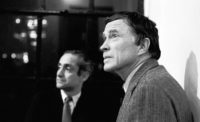A New Biography, Written with Sympathy and Style, Delves into the Life of Vincent Scully
Review: 'Vincent Scully: Architecture, Urbanism, and a Life in Search of Community' by A. Krista Sykes

Specialization, according to a familiar quip, is the condition of coming to know more and more about less and less, until one knows everything about nothing.
The historian and critic Vincent Scully (1920–2017) did not suffer from this condition. He may have refused to write about places he had not visited in person, but in other regards his work was staggeringly expansive. Over the course of his long career, he published on the orientation of ancient Greek temples and the rituals of Pueblo architecture, on Palladian villas and French gardens, on Frank Lloyd Wright and Louis Kahn, on Modernism and New Urbanism. Possessed of an infectious enthusiasm for architecture as the setting for humanity’s aspirations writ large, he refused to compartmentalize his commitments, allowing his critique of the present to inform his reading of history and his hopes for the future. He published prodigiously. But above all, he taught. At one point, nearly a fifth of Yale’s undergraduates took his courses each year.
Vincent Scully: Architecture, Urbanism, and a Life in Search of Community, a carefully researched biography written with sympathy and style by A. Krista Sykes, allows all of us to witness the impact of a teacher upon the lives of his students. It invites us into Scully’s darkened classroom as the slides advance and the story of architecture unfolds. The careful reader becomes Scully’s student. This is, in a sense, a book for those of us who did not complete an undergraduate education at Yale.
Sykes sets the story of Scully’s career into its larger context—from the childhood of a working-class New Haven boy who did not obviously belong at Yale to the experience of a Marine Corps officer hurtling across the landscape of North Africa on the back of a motorcycle during World War II. Sykes narrates the expanding relationships of a critic who was friend and, sometimes, adversary to the figures who shaped America’s architectural culture during the second half of the 20th century. She also introduces the women who made possible his extraordinary celebrity. She describes the convictions of a professor who was able to criticize the institution that nurtured him while defending the principles for which it stood, and she assesses the character of an academic who remained willing to learn as he grew older, changing his mind as the world changed around him. In telling this story, Sykes establishes Scully’s place within the narratives of architecture’s pedagogy. Though some might like to take their history in the form of textbooks, this book covers the ground of the last century’s architectural debates through the more accessible genre of the biography, humanizing a story that is often presented in a drier, less personal voice.
Along the way, Sykes makes the case for preserving—despite the relentless growth of academic specialization—a broader and more generous approach to architectural history, one that draws connections across boundaries of space and time in order to extract meaning from the brute violence of history and that proves to be engaging not only to emerging professionals, but also to a nonspecialist audience. Such an approach bears witness not to disciplinary divisions but to a shared humanity, while still recognizing architecture as an agent of change. It is eager, in other words, to do nothing less than to explore what it means to be human.
There are dangers here, to be sure. The author is conscious, for example, that attention to similarities across cultures can obscure meaningful differences. But advocates for the underlying humanism of Scully’s pedagogy might note that our own cultural moment can supply specialists aplenty, but rarely errs on the side of empathy. Indeed, the fact that Scully’s lessons could stand to be reinforced, now more than ever, makes this book unusually pertinent. As William Jordy once put it in a review of Scully’s 1955 The Shingle Style, “Everyone interested in American culture should read this book, the more so because Mr. Scully’s theme has implications for our cultural future as well.”



